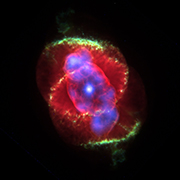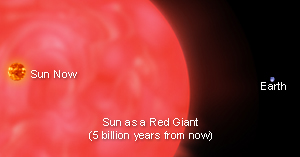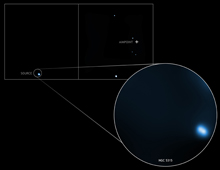Disclaimer: This material is being kept online for historical purposes. Though accurate at the time of publication, it is no longer being updated. The page may contain broken links or outdated information, and parts may not function in current web browsers. Visit chandra.si.edu for current information.
When Serendipity Becomes Science:
by Dr. Joel Kastner, Professor & Graduate Coordinator(Center for Imaging Science, Rochester Institute of Technology)
September 27, 2007 ::
We teach our children (even as we try to convince ourselves) that science proceeds in measured steps, via -- fanfare here -- the Scientific Method. That is, the endless cycle of hypothesize, predict, measure, modify the hypothesis, and repeat, ad nauseaum. But this simple cycle lacks a critical element that, more often than not, drives the entire scientific enterprise: serendipity.
Indeed, perhaps more than any other science, astronomy relies on serendipitous discoveries, often (though not necessarily) made with state-of-the-art instrumentation, as a means to progress from the known into the unknown universe. Sometimes this serendipity is profound, sometimes it's mundane, and sometimes it involves the irony of a discovery missed and then later salvaged. This little tale of serendipity is of the last variety.
First, some background. Since its launch, Chandra has provided essential new insight into the violent processes involved in the deaths of stars, even those as "pedestrian" as our own Sun. As Sun-like stars exhaust their nuclear fuel, they expand into red giants, generating power at levels thousands of times that of the present-day Sun and rapidly shedding their outer atmospheres. The emerging, white-hot core of the star -- a future white dwarf star -- bathes the ejected atmosphere in ultraviolet radiation, setting it aglow as a planetary nebula (so named because of the superficial resemblance of such objects to planets, when viewed through early telescopes).
X-ray imaging and spectroscopy by Chandra and by its European counterpart, XMM-Newton, have vividly demonstrated that during the planetary nebula phase the rapidly accelerating stellar wind blown by the emerging white dwarf collides with the slowly moving red giant atmosphere, heating the wind to millions of degrees (see 2006 Chandra PN gallery ). This process of colliding winds process likely plays a central role in producing the baffling variety of shapes observed in the many gorgeous Hubble Space Telescope images of planetary nebulae.
Heartened by this leap forward in our understanding of the process of stellar death, my colleagues Orsola De Marco (American Museum of Naturual History), Noam Soker (Technion, Israel), Bruce Balick (University of Washington) and I began to try to hone in on the specific properties of the dying stars at the cores of planetary nebulae that might produce the most violent collisions and, hence, the brightest X-rays. We started to focus on planetary nebulas with so-called Wolf-Rayet type stars -- a special class of hot, hydrogen-deficient stars that display particularly massive and energetic stellar winds -- at their cores.
In hindsight, of course, the notion that the most violent wind collisions should be taking place in those objects with the strongest winds is not such an Earth-shattering hypothesis. So we were not particularly surprised when we began to find that one was more likely to detect X-rays from a planetary nebula if the nebula surrounded a Wolf-Rayet type star. Indeed, it began to appear that the majority of the planetary nebulae detected as X-ray sources by Chandra and XMM-Newton might be of the Wolf-Rayet type variety, even though less than 10% of planetary nebulae have been identified as containing such a central star.
However, it seems not every Wolf-Rayet planetary is a bright X-ray source. For example, we had failed to detect X-rays from the object Hen 2-99, which contains a relatively cool (hence perhaps only very recently unveiled) Wolf-Rayet central star. We speculated that perhaps Hen 2-99 is so young that its central star "fast wind" has yet to impact its previously ejected red giant envelope. Clearly, we needed to request Chandra pointings toward additional planetary nebulae, especially those with Wolf-Rayet stars, to understand why some planetary nebulae display bright X-rays, while others don't.
So I almost fell out of my chair this past March when my graduate student Rudy Montez --- who, at the time, was hard at work identifying planetary nebulae that might be good candidates to observe wth Chandra --- came into my office and told me the following. I paraphrase only slightly:
"Were you aware that the planetary nebula NGC 5315 was detected 'accidentally' by Chandra? It seems the investigator who initiated the observation in question is named Kastner. But wait, it gets better. The observation in question was aimed at a DIFFERENT planetary nebula (Hen 2-99) which, as you might remember, was NOT detected. [Indeed, Rudy, Orsola, Noam and I had included a discussion of the lack of X-rays from Hen 2-99 in Rudy's paper announcing the discovery of X-rays from the Wolf-Rayet object NGC 40. The planetary nebula we DID detect just happens to sit at the extreme edge of the field of view of the ACIS detector array."
Oh yes, and one last thing ... but perhaps you guessed this already: NGC 5315 has a Wolf-Rayet-type central star! Since there are only about 50 Wolf-Rayet-star planetary nebulae known in the entire sky, the probability of accidentally placing one in a given Chandra ACIS image is about 0.01%. It's then that much more surprising that we could, with Chandra, bag two such objects for the "price" of one.
Regardless, with the accidental detection of NGC 5315, we are that much more confident in the hypothesis that the presence of a particularly "hard-blowing" central star is essential to the production of bright X-rays within a planetary nebula. Hence, planetary nebula science inches forward --- propelled in this case by serendipity, indeed irony -- rather than via carefully crafted experimentation.
As much as it testifies to Rudy's alertness and vigilance -- and, perhaps, my lack of intuition in pointing Chandra at the wrong object! -- the preceding story really speaks to the importance of maintaining a solid, readily accessible data archive in support of a Great Observatory like Chandra. Such an archive should enable unanticipated (or just plain overlooked) discoveries potentially much more profound than our accidental X-ray detection of NGC 5315. Indeed, perhaps the ultimate irony about serendipity in science is that it is, more often than not, the direct consequence of meticulous planning.
Disclaimer: This material is being kept online for historical purposes. Though accurate at the time of publication, it is no longer being updated. The page may contain broken links or outdated information, and parts may not function in current web browsers. Visit chandra.si.edu for current information.











